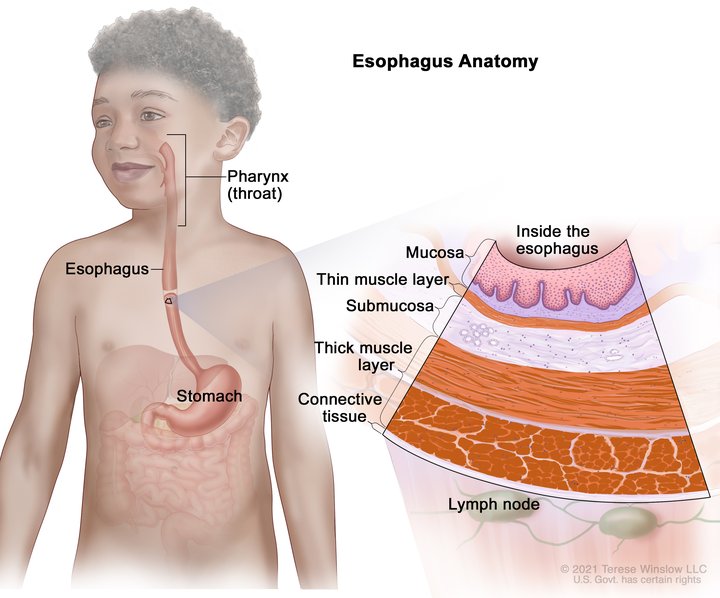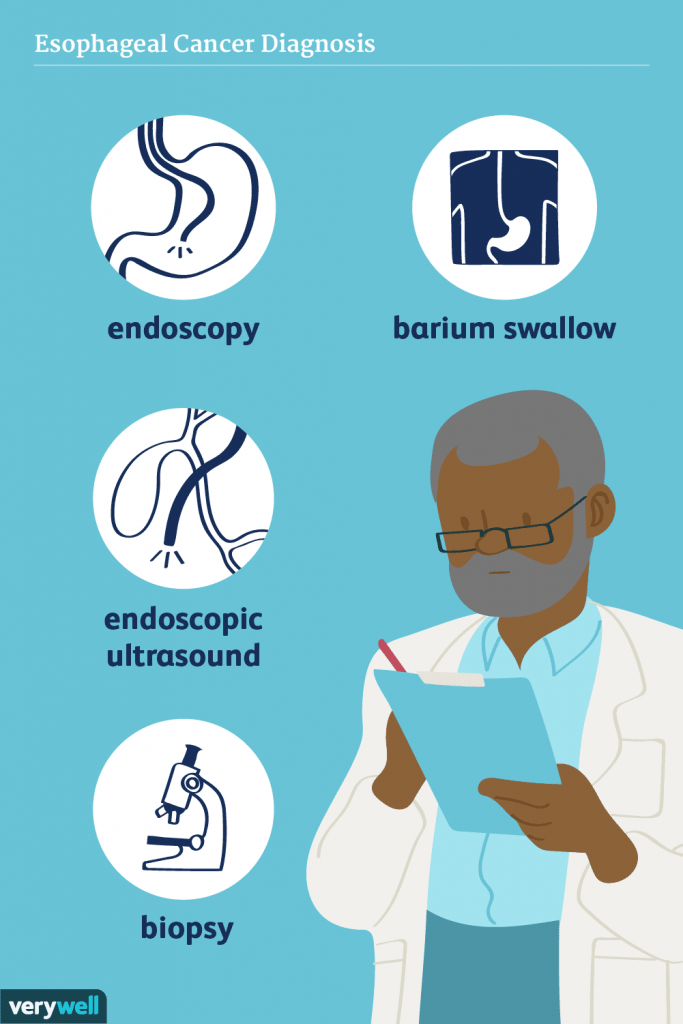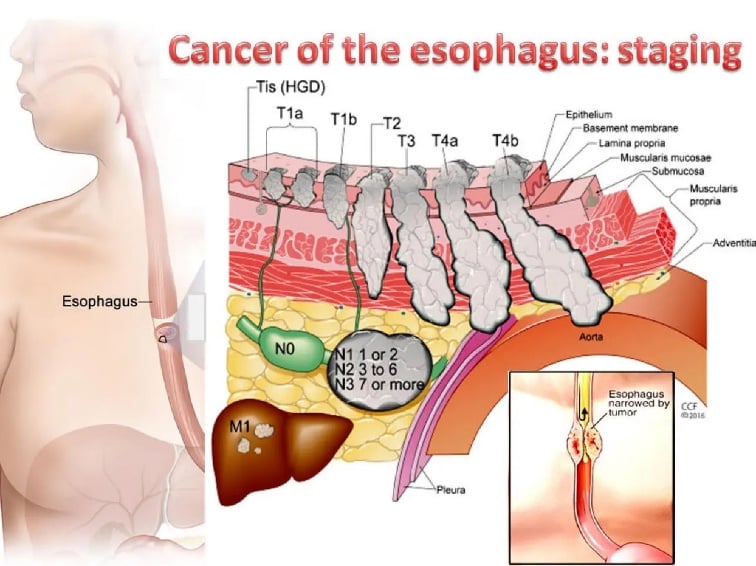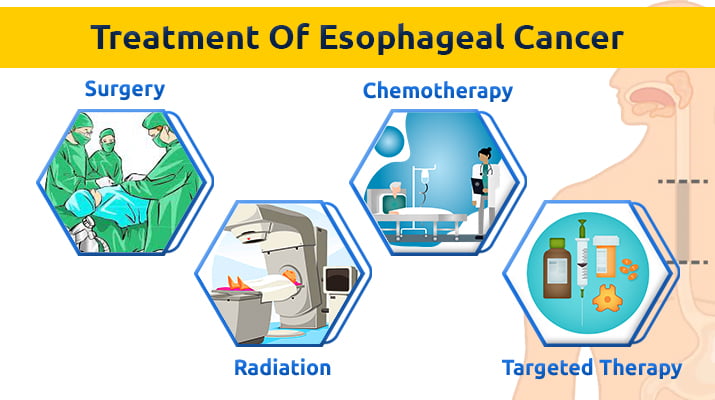Oesophageal Cancer
A cancer, is to put it simply, is an abnormality formed when the normal cells that comprise a tissue or organ turns into abnormal cells, that unlike its normal counterpart does not die and starts to spread to other regions within the proximity or even further. The reason for the formation of these abnormal cells […] Read More
Top Doctors For Oesophageal Cancer Treatments
Top Hospitals For Oesophageal Cancer Treatments
Oesophageal Cancer
Table of contents

What is an oesophagus?

The oesophagus, also known as the food pipe, is a long, muscular tube that connects the mouth to the stomach. With an approximate length of about ten inches in adults, it functions as a passageway for the food and fluids we consume to the stomach. The oesophagus comprises several layers of muscle that contract to help move food down the tube into the stomach. Layers of the oesophagus are listed below:
Mucosa: The innermost layer’s main function is to provide the pathway for food to move through the pipe.
Sub mucosa: the mucosa’s lifeline; it helps it by supplying blood and necessary nutrients to it.
Muscle Layer (muscularis): muscles that push the food down the pipe.
Outer Layer (serosa)
What is oesophageal cancer?
Oesophageal cancer occurs whenever there is abnormal cell growth in the oesophageal tissues. Over some time, these cells form a mass called a tumor.
What are the types of oesophageal cancer?

Oesophageal cancer, based on the location and the type of cells it affects, is divided into two categories:
Squamous Cell Carcinoma: arises in the cells of the mucosa (squamous cells) and is commonly seen in the middle and upper parts of the oesophagus. Incidence rates of this kind of cancer are relatively high in Asian countries.
Adenocarcinomas: arises from the glandular cells of mucosa. It generally occurs in the lower part of the oesophagus.
The above two cancers represent ninety-five percent of the total oesophageal cancer cases. It is to be noted that if oesophageal cancer is left untreated, it could lead to cancer growing through the walls of the food pipe and affecting the neighboring organs, tissues, and lymph nodes.
How is oesophageal cancer diagnosed?

In case the doctor suspects oesophageal cancer, the doctor would recommend/perform the following tests:
Medical History and physical exam: The doctor will record the patient’s medical history to look for risk factors that may affect the chances of being diagnosed with oesophageal cancer and also examine the patient for other medical problems.
Imaging tests: They include X-ray scans, ultrasonography scans, CT scans, MRI scans, and PET scans. All these scans help in locating the tumors and also help in measuring the size of the tumor and the spread (metastasis) of tumors to other parts of the body.
Endoscopy: involves using a flexible tube to determine the location of the cancer by sending it down the throat or nose.
Barium Swallow: They use a special series of x-rays to visualize the oesophagus during this procedure. The patient is asked to drink a liquid containing barium, making the oesophagus easier to view in an x-ray scan. A barium swallow is helpful to diagnose strictures (narrowing of the oesophagus).
Bronchoscopy
Biopsy: Involves taking samples from the affected region and checking for cancer.
The results of these tests are analyzed, and the state of the patient’s cancer is quantified by staging the cancer and grading the tumor that describes it. Staging involves using widely accepted terminology to describe the state of the cancer to the doctor efficiently. Grading, on the other hand, involves comparing the tumor with a standard normal cell that would otherwise be in its place and evaluating how far from normal the tumor is spread.
What are the stages of oesophageal cancer?

A commonly used system to describe the extent of the cancer is the TNM system, where T stands for tumor, N stands for nodes, and M stands for metastasis. It’s on these three parameters that the cancer is described, as discussed below:
Tumor (T): Describes how far the tumor has grown into the esophageal walls and surrounding tissue. It is staged on a scale of 0 to 4 to describe how deep the tumor s extent is and may also have subcategories under each. These stages are as follows:
TX: The tumor cannot be evaluated.
T0: No tumor found.
Tis: Describes the earliest stage of oesophageal cancer: found on a small area on the lining of the oesophagus without any further spread.
T1: Tumors found on the lining of the mucosa and also through the layers of the submucosa.
T2: Tumor has spread through the mucosa but not through the outer layer of the oesophagus.
T3: Spread through all the walls of the oesophagus but is still restricted to the oesophagus.
T4: Has spread to other tissues surrounding the oesophagus.
Nodes (N): Stands for lymph nodes present near the oesophagus (also called regional lymph nodes) and are staged from 0 to 3.
NX: Lymph Nodes cannot be evaluated.
N0: No cancer found on lymph nodes.
N1: Spread to 1-3 lymph nodes near the tumor.
N2: Spread to 3-6 lymph nodes near the tumor.
N3: Spread to 7 or more lymph nodes near the tumor.
Metastasis (M): This parameter denotes if the tumor has metastasized (spread) to any distant organ.
MX: Metastasis cannot be evaluated.
M0: Cancer has not metastasized to any other distant body part.
M1: Cancer has metastasized to any other distant part of the body.
Grading:
Involves comparing a healthy normal tissue with the cancerous one. It is said to be differentiated if healthy cells are present in the tissue amongst the cancerous ones. However, it is said to be poorly differentiated if it has more cancerous cells than healthy cells. On this basis, the tumors are graded on a scale of G1 to G4, where G1 is the best well-differentiated and G4 is poorly differentiated or mostly cancerous cells.
How is oesophageal cancer treated?

Evaluating the test results and the present situation, the doctor may recommend the following treatments:
Surgery
This can be used alone or in combination with other treatments to remove the cancer. Based on the various cases, the kind of surgery chosen falls under three categories:
If in the presence of small tumors confined to a small area, the doctor may remove it and the marginal part of healthy tissue with the help of an endoscope passed down the throat.
Esophagectomy (Surgery to remove a portion of the oesophagus): involves removing the part of the oesophagus with the tumor and a portion of the upper part of the stomach with nearby lymph nodes. The stomach is then brought up to meet the remaining oesophagus.
Esophagogastrectomy (Surgery to remove a part of the oesophagus along with the upper portion of the stomach): Same as esophagectomy, but a larger part of the stomach is removed.
Esophagectomy and Esophagogastrostomy procedures are usually performed between a choice of two methodologies: open surgery or minimally invasive laparoscopic surgery. Open surgery involves making two cuts to reach the oesophagus: these cuts may be in the neck and abdomen (also called trans hiatal oesophagectomy) or in the chest and abdomen (also called trans thoracic oesophagectomy). A new entrant in the field of surgery is a keyhole or laparoscopic surgery, which involves making use of smaller cuts through which instruments required are passed along with a laparoscope attached to a fiber-optic camera to allow the surgeon a clear view of the area they are operating on. Though it is less invasive than its open counterpart and tends to have a better healing time, it is limited in terms of flexibility that the surgeon can work with. It also takes longer than conventional open surgery. It is thus crucial that the patient should discuss with their doctors before they choose the surgical procedure.
Chemotherapy
Chemotherapy is usually given to patients with cancer that has metastasized to other parts of the body or cannot or choose not to take a surgical procedure to remove the affected oesophagus. Chemotherapy is generally administered in cycles, with intervals between them to allow the body to heal and recover, and the treatment lasts for a couple of weeks. The patient may face a few side effects while undergoing this treatment; however, most of the time, these symptoms would only last for a few days. Some of them are fatigue, hair loss, mouth sores, loss of appetite, and diarrhea. Also, chemotherapy tends to weaken a person’s immune system making them susceptible to easy bleeding and infections.
Radiation therapy is a high-powered treatment that kills cancer cells using powerful beams such as X-rays. Like chemotherapy, it is also used before or after surgery. Radiation therapy is administered: via an external machine: the affected area is measured carefully with the help of the tests performed, and radiation is introduced to that area or via brachytherapy: which involves placing high-intensity ray emitting pellets near the affected area with the help of a catheter. However, this procedure may have temporary side effects like nausea, skin changes in the treatment area, hair loss, diarrhea, fatigue, painful sores, etc.
Symptoms

Oesophageal cancer is a serious problem. They are usually found when the patient notices or complaints about symptoms. Rarely is it diagnosed in people without symptoms, and when it is, it is usually found in cases where the patient was performing tests for other treatments. The symptoms usually kick in during the advanced stages of the cancer, so the patient and the doctor must be able to identify the reason for the complications. Also, noting that these symptoms can be associated with other medical issues doesn’t always mean that the patient in question has oesophageal cancer. Some of these signs are:
- Trouble in Swallowing: most common symptom, as cancer grows in the oesophagus, patients may complain about a feeling of food being stuck in their throat and may prefer to eat in small pieces or soft foods. Also, may complain about bringing up lots of thick mucus and saliva.
- Chest pain: Patients may experience pain or discomfort in the middle of their chests. However, it may also be a symptom of heartburn and not cancer.
- Weight Loss: due to swallowing problems, a decrease in appetite, or a higher metabolism due to the presence of cancer.
Other symptoms:
- Hoarseness
- Chronic Cough
- Vomiting
- Hiccups
- Bone Pain
- Pneumonia
- Bleeding into the oesophagus
Causes

The exact cause of oesophageal cancer is not known. While there are a few risk factors that can initiate a potential to develop oesophageal cancer in the future, they are:
- Smoking and high alcohol consumption
- Lack of sufficient fruits and vegetables in the diet
- Frequently eating smoked, salted, or poorly refrigerated food and drinking very hot liquids.
- Obesity
- Medical conditions where a person has repeated episodes of reflux (heartburn) where the acids from the stomach back up into the oesophagus, hurting it, a condition called Gastro-oesophageal reflux (GORD). As the damage continues over time, the cells that line the oesophagus get replaced by new cells, a condition called Barrett’s disease.
FAQ
The prognosis of oesophageal cancer depends upon various factors such as the stage of cancer, severity of cancer, age of the patient, and overall condition of the patient. Early diagnosis and early treatment help in the recovery of the patient completely. Cancers detected in the late stage have a poor prognosis since the cancer cannot be operated on, and the cancer has spread to other parts of the body.
Oesophageal cancer cannot be prevented completely, but certain risk factors can be taken care of to minimize the severity of oesophageal cancer. They are:
a) Avoid cigarette smoking and tobacco chewing
b) Reduce the consumption of alcohol
c) Maintain a healthy lifestyle and diet plan
d) Exercise regularly
e) Take lots of fruits and vegetables.
Oesophageal cancer is considered the 6th most common cancer in the world. Oesophageal cancer can be fatal if not treated early.
The most common complications of oesophageal cancer are:
a) Bleeding
b) Pulmonary (lung) complications
c) Anastomotic leaking
d) Reflux esophagitis
e) Infections
f) Pulmonary embolism (blood clots)
Squamous cell carcinoma is considered the most common type of oesophageal cancer.

































































































